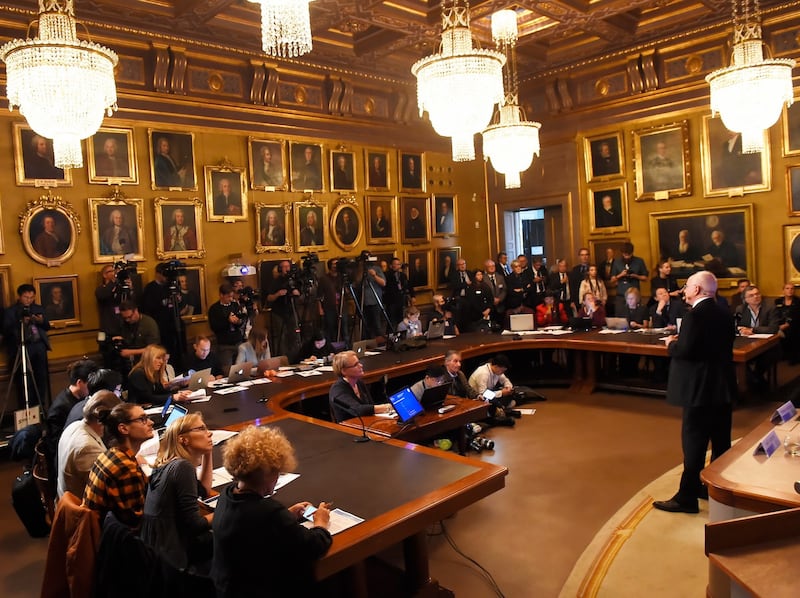It has entries on the Radioactive Boy Scout, Oscar the death-predicting cat and the man with the longest beard in recorded history, but until yesterday, when Donna Strickland became the first woman for 55 years to win the Nobel Prize in Physics, Wikipedia wasn't convinced she merited her own page in the online encyclopedia.
The Canadian scientist, who is based at the University of Waterloo, in Ontario, was one of a trio to receive the award for breakthroughs in laser technology that have turned light beams into precision tools for everything from eye surgery to micro-machining.
The only other women to have won the physics prize are Marie Curie, who received it in 1903, and Maria Goeppert Mayer, who won in 1963. And Strickland is one of only 50 women – including Frances Arnold, who was today announced as a recipient of this year's chemistry award – ever to have won a Nobel Prize, compared with almost 850 men.
Today marks the first day in my lifetime that there's been a living recipient of the Nobel Prize in physics who is a woman-Donna Strickland. Although, her university hasn't promoted her to full professor and she didn't have a Wikipedia page until ~2 hours ago.
— Dr. Jamie R Lomax (@jrlomax) October 2, 2018
Only 17 per cent of the current biographical entries on Wikipedia are about women, and the site is regarded as particularly thin on women in science
But searching for Strickland's name on Wikipedia would have returned no entry for her at the time of yesterday's announcement. Strickland was mentioned in an article about another of this year's laureates, yet, as recently as May, editors at the collaborative reference site did not believe her work deserved its own page. They rejected a submission for a page on Strickland, they said, because the references it cited did not show "significant coverage (not just passing mentions) about the subject".
Within two hours of being announced as a winner of this year's Nobel Prize in Physics she was finally given a Wikipedia page. Only 17 per cent of the current biographical entries on Wikipedia are about women, according to one analysis, and the site is regarded as particularly thin on women in science.

Strickland, who is 59, shared her Nobel Prize with the French physicist Gérard Mourou, who is 74 – she was working with him as a graduate student when they published their groundbreaking scientific paper, in 1985 – and Arthur Ashkin, a 96-year-old American scientist who invented "optical tweezers". (Ashkin will receive half of the monetary prize, which is worth about €850,000. Mourou and Strickland will split the remainder.)
So who is Donna Strickland? A self-described “laser jock,” she was born in Guelph, Ontario, in 1959. After her work with Mourou resulted in that first published scientific paper, 33 years ago, Strickland went on to base her doctoral dissertation on it. At the time, scientists had been trying to work out how to amplify high-energy laser pulses without destroying the amplifiers. Strickland, who now runs a laboratory for students at Waterloo called the Ultrafast Laser Group, suggested stretching out the pulses in time, amplifying them and then compressing them again to the desired level of intensity.
Strickland's work with Mourou "paved the way towards the shortest and most intense laser pulses ever created by mankind," according to nobelprize.org. Their method, known as chirped pulse amplification, allowed for more precision in laser technology and has allowed for several real-world applications, including Lasik eye surgery. Some physicists think it can one day be used to accelerate subatomic particles, just like the large hadron collider at Cern, the European physics research centre.
One of Strickland's fellow woman physicists, the astronomer Dr Jamie Lomax of the United States Naval Academy, was one of numerous observers to point out yesterday that Strickland is still only an associate professor at the University of Waterloo, a mid-level position that seems not to reflect the importance of her work.
And only a day earlier Cern suspended an Italian scientist, Alessandro Strumia, for telling a seminar at the organisation’s Swiss headquarters last week that physics was “invented and built by men”.
Obviously we need to celebrate women physicists, because we are out there, and hopefully, in time, it will start to move forward at a faster rate
All of this highlights women scientists’ low profiles and continuing difficulties in earning recognition. “Obviously we need to celebrate women physicists, because we are out there, and hopefully, in time, it will start to move forward at a faster rate,” Strickland said yesterday, shortly after learning of her prize.
Last year’s nine science laureates were all men from western countries, and the Nobel Prizes have come under criticism in recent years for the lack of female laureates across all categories. While women are generally underrepresented in fields like science and technology, the disparities in physics seem to be particularly pronounced, according to Rachel Ivie, director of the statistical research centre at the American Institute of Physics.
Ivie cites institutional issues that have made it more difficult for women to advance their careers, such as maternity leave, which can take women out of the workplace for months or years at a time. But Ivie adds that there seem to be cultural reasons for the disparities, too. That could explain why the change has been especially slow in physics even though women are increasingly represented in the field. “It hasn’t really caught up yet to the other fields,” she says. “And I think a lot of that is the cultural perception that this is a man’s science, for whatever reason.” – New York Times, agencies










